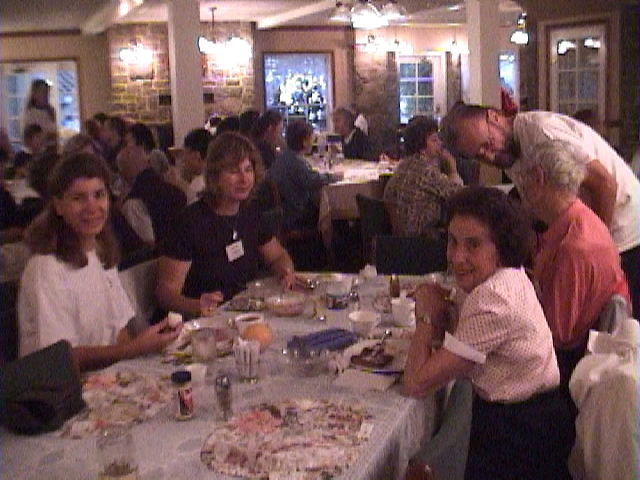 |
Lunch time at the Glen Ivy Retreat, March 2001. |
How to keep balance-- standing on one leg (Spring Leg and Flex Foot): The Captain's Wheel
Standing on one leg while flexing the other requires some muscle strength and balancing skill. The muscle strength is easy to obtain: just do the one leg standing (alternate legs) everyday for ten minutes for about a month.
Balancing skill is more subtle and require some "thinking". Some people visualize the standing leg as a tree trunk with roots growing out from the foot into the ground; while others concentrate their mind on the moving leg. Yet the two visuals are not adequate as the tree trunk is too rigid, not flexible and focusing on the moving part requires too much attention, thus tensing up one's body.
During the Glen Ivy retreat, we came up with a visual: turn the tailbone (coccyx) as if the tailbone were turning a Captain wheel in a ship (the wheel is being flat in this case). So if you want to turn your foot to make a circle, then you would turn your tailbone first. The force (via chi) of the tailbone will transfer to the foot, making a circular movement. Change directions in the tailbone will change the directions of the turning of the foot. When doing the flex up and down of the foot, you will need to move your tailbone as if pushing a heavy object up and down.
Warning: The purpose of visualizing a physical object or the mechanics of moving a physical object is to obtain the power of the non-physical, invisible, subtle energy, chi for healing. So don't become the physical object itself. The visualized object is the means not the end. If you start to ask how large the wheel, what color, how heavy, how large the tailbone relative to the wheel, how can the tailbone move a wheel, etc, you are going too far. Instead, ask yourself, do I feel more balanced by using this visual. If you don't feel more balanced, this visual is not suitable for you. You need to find your own visual. If you have found one, please let me know. Qigong is an evolving art, it is limited only by your imagination!!!!
 |
Lunch time at the Glen Ivy Retreat, March 2001. |